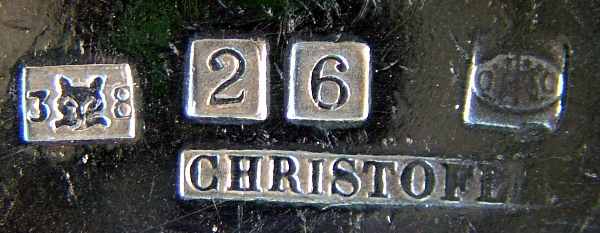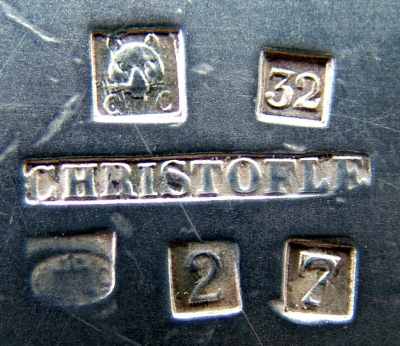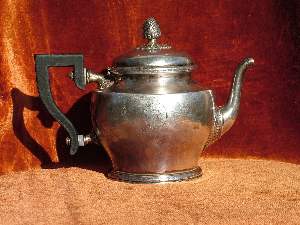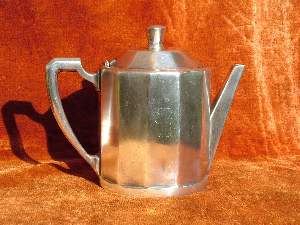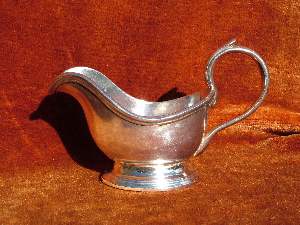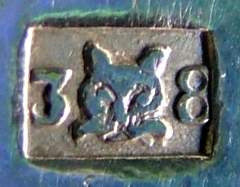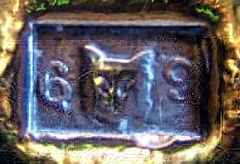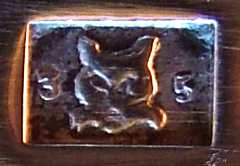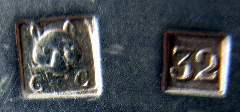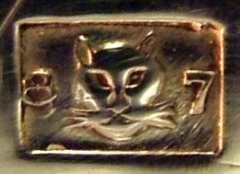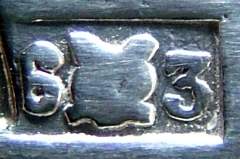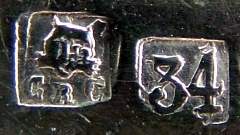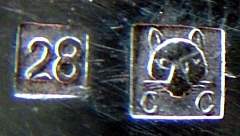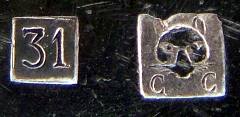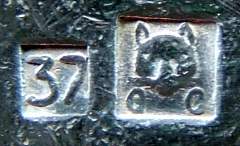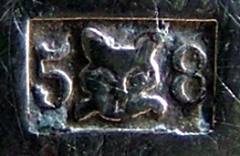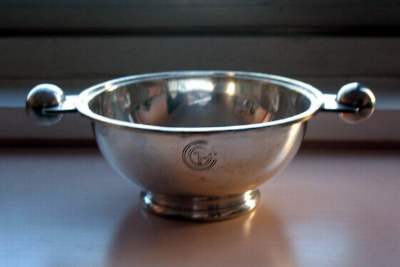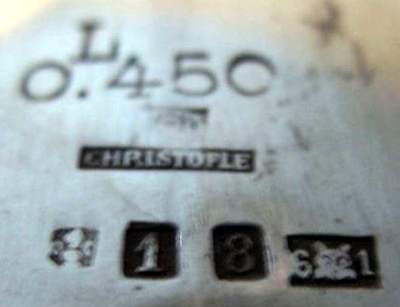 ASSOCIATION OF SMALL COLLECTORS OF ANTIQUE SILVER
ASSOCIATION OF SMALL COLLECTORS OF ANTIQUE SILVERASCAS
| article # 144 |
|
|
|
(click on photos to enlarge image)"CAT" MARKS OF CHRISTOFLE FOREIGN BRANCHES OPERATED BETWEEN 1910 AND 1940In 1854 (Literature: 1) (or 1856 Literature: 2), the famous French silversmith company Christofle opened its first branch at Karlsruhe, Germany (at that time Grossherzogtum Baden or Grand Duchy of Baden). The reason for moving the manufacturing abroad was purely economic, namely, to reduce the huge custom taxes. The scheme was very simple: the semi-finished product, fully prepared for silver-plating, was made in Paris, while its silvering took place in Karlsruhe. Further the Karlsruhe foundry opened its own subsidiary company in Vienna, Austro-Hungary (Literature: 2). The XIX century pieces, silvered at Karlsruhe and Vienna, cannot be distinguished from genuine Paris-silvered items, as all marks were the same and, what is essential, the ordinal number was in accordance with the Paris one (no special numbering was used). The only visible difference was the slightly reduced contrast of all the marks as they were put before the silver-plating. In the XX century, with the opening of numerous new Christofle branches, the situation changed. Now all the pieces, issued by Christofle branches in 1910-1940, used their own marks, which I called "cat" marks. Usually, these marks look sharp in comparison with the marks of their mother company. Typical examples of branch mark layout relative to the Christofle marks are illustrated by Figs.1-2.
After the end of World War I, both the Karlsruhe and Vienna factories were closed (the Karlsruhe one in 1921 Literature: 3-4). However, in 1924, two new Christofle branches were opened - one at Musso, near Milan (Italy), and the other at Peseux (Switzerland) (Literature: 3-4). In the mid-twenties, the Buenos-Aires subsidiary company was also opened, but its operation was short-lived (Literature: 5). The world economic crisis of 1929, which hit France in 1930, brought about the closure of the Musso branch in 1930-1932. The subsidiary company at Peseux (Switzerland) survived until the Second World War, but had diminished its production significantly (Literature: 6).
During the last two years I have purchased a number of Christofle items (Figs. 3-6), issued between 1910 and 1940 and bearing the cat marks. These marks are presented in Table 1 in chronological order. Each mark contains a cat head and two digits, sometimes the digits are given in a separate box. So far, I have not managed to understand their meaning, although I have established that these digits have no relation either to the year of production or to the silver content. The initials "CC" under the cat stand for Charles Christofle. The calculation of production dates from the ordinal numbers was made according to the recently proposed method (Literature: 7). The accuracy of this method is less than 2 years for the above-mentioned period of time.
TABLE 1. Cat marks, their characteristics and attribution
The first conclusion, which could be made from the consideration of Table 1, is that the marks Nos. 1-3 are related to the Karlsruhe and/or Vienna branches, as only these branches were active before 1924. After 1924, the other three subsidiaries were active: Musso, Peseux and Buenos Aires. Recently, a silver-plated fruit bowl from the NORMANDIE transatlantic liner was auctioned on ebay (Fig.7). This liner was built in 1935 and in accordance with that the "OC" Christofle oval/rectangular mark and the "OC" silver-plating designation, used after 1935, appeared on the item's mark (Fig.8) (Literature: 8). In the lower row of this mark on the right side a cat mark with two digits inside is clearly visible. This fact proves that the marks Nos.5-6, 11 belong to the Peseux branch, since only that Christofle subsidiary was active at this time. From the remaining marks, No.4 and Nos.7-10, I can attribute the No.7 to the Buenos Aires branch as the rarer one. It should be noticed that the cat mark of the
Musso branch resembles one of the Gallia marks
(Literature: 9). However, the corresponding Gallia mark was
never accompanied by the square box with a double digit number.
Besides, the size of the Gallia mark used at the same time was
significantly smaller, between 1.7 mm x 1.7 mm and 2.0 mm x 2.0
mm. LITERATURE1. Marc de Ferrière, Christofle: 150 ans d’Art et de Rève. Dossier de l’Art, No.2, pp.3-73 (1991). 2. Marc de Ferrière le Vayer, Christofle: a family firm. In: Management and Business in Britain and France: the Age of the Corporate Economy, edited by Youssef Cassis, François Crouzet and Terence Richard Gourvish (Clarendon Press, Oxford, 1995), pp.72-87. 3. David Rosenberg, Christofle (Assouline, New York, 2006), pp.73-74. 4. Christofle, http://www.thestudioprojects.co.nz/products/brands/christofle.html 5. Robert Massart, Silver pepper pots of the 19th and 20th centuries, http://www.ascasonline.org/windowottob65.html 6. Marc de Ferrière le Vayer, private communication. 7. David N. Nikogosyan, Numeration in silver-plated Christofle hollow ware and its application to items dating, http://www.ascasonline.org/articoloDICEM140.html 8. David N. Nikogosyan, An unknown mark for silver-plated hollow ware used by Christofle in 1930-1935, http://www.ascasonline.org/articoloGIUGN130.html 9. David N. Nikogosyan, Marks of European silver plate: VII. Gallia, Alfenide/Christofle, France, http://www.ascasonline.org/WINDOWOTTOB77.html David Nikogosyan can be contacted at niko@phys.ucc.ie
|
